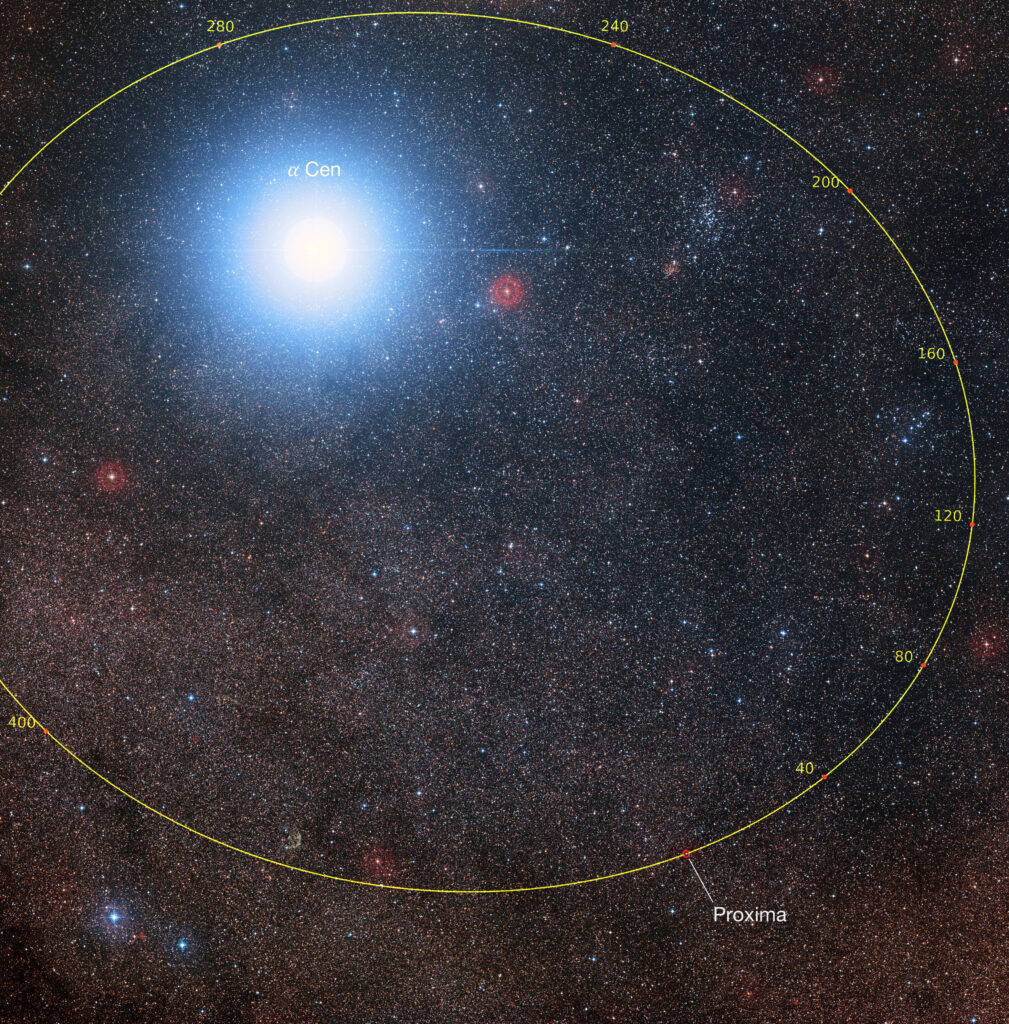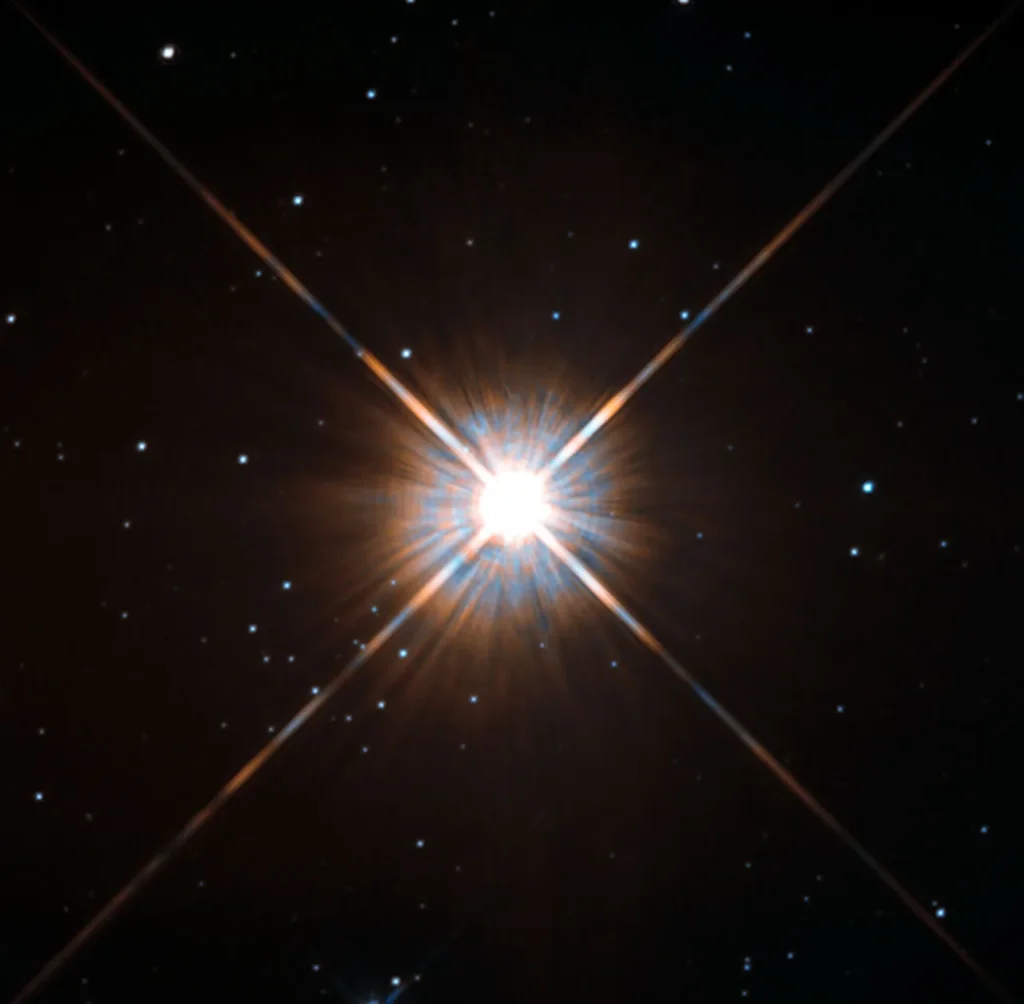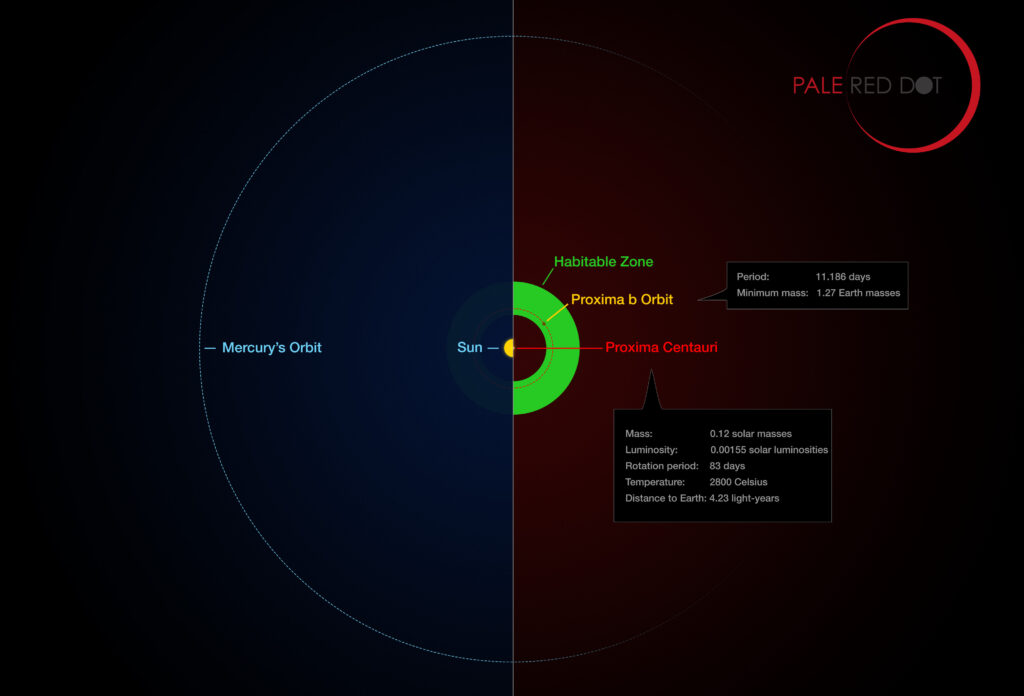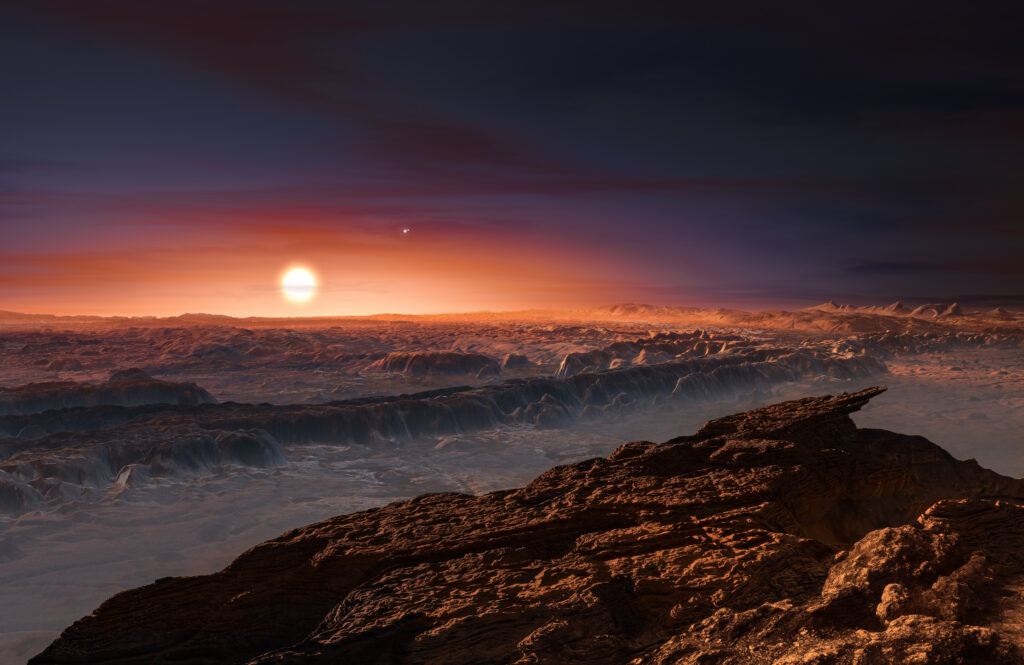Nearest Stellar Neighbour
© ESO/M. Kornmesser
Table of Contents
In the expanse of space, stars appear to be distant points of light, several light-years apart. However, the closest star to our solar system is Proxima Centauri, located within the Alpha Centauri star system and around 4.2 light-years away from the Sun. Proxima Centauri is a red dwarf star, the most common type of star, which is about seven times smaller than the Sun and little more than half as hot at 3,100 kelvins. The small star is barely 50% larger than Jupiter.
The red dwarf star has approximately 12.5% of the Sun’s mass and an average density of 33 times that of the Sun. Because Proxima Centauri is close to Earth, its angular diameter may be determined directly. Its true diameter is around one-seventh (14%) that of the Sun. Despite its low average luminosity, it is a flare star whose brightness fluctuates dramatically due to magnetic activity.
Proxima Centauri has one known exoplanet and two candidates: Proxima Centauri b, Proxima Centauri d, and the disputed Proxima Centauri c. Proxima Centauri b orbits the star at a distance of about 0.05 AU and has an orbital period of around 11.2 Earth days. Its estimated mass is at least 1.07 times that of the Earth.
Proxima b orbits within Proxima Centauri’s habitable zone, the temperature range where liquid water can exist on its surface. However, because Proxima Centauri is a red dwarf and a flare star, the planet’s habitability is highly unclear. Proxima Centauri c, a potential super-Earth located about 1.5 AU distant, orbits it every 1,900 days (5.2 years). A candidate sub-Earth, Proxima Centauri d, roughly 0.029 AU away, orbits it every 5.1 days.
CHARACTERISTICS

© P. Kervella (CNRS/U. of Chile/Observatoire de Paris/LESIA), ESO/Digitized Sky Survey 2, D. De Martin/M. Zamani
PHYSICAL CHARACTERISTICS
Mass and Size: Proxima Centauri is classified as a red dwarf star, specifically of spectral type M5.5, which places it at the low-mass end of M-type stars. Its mass is approximately 12.5% that of the Sun, or about 0.123 solar masses. In terms of size, Proxima Centauri has a diameter of roughly 14% that of the Sun, making it significantly smaller than our solar star. Its density is notably high, about 33 times denser than the Sun.
Temperature: Proxima Centauri’s effective temperature is estimated to be around 3,050 K, although some sources indicate a slightly lower temperature of about 3,100 K. This temperature contributes to its classification as a red dwarf, giving it a reddish hue and placing it on the cooler side compared to the Sun, which has an effective temperature of approximately 5,778 K. The star’s chromosphere is active, with temperatures in its corona reaching about 3.5 million K, which is higher than that of the Sun’s corona.
Luminosity: Proxima’s luminosity is extremely low compared to the Sun; it emits only about 0.16% of the Sun’s total luminosity across all wavelengths. In visible light, this drops to an even lower figure of approximately 0.0056%. Most of Proxima Centauri’s emitted energy is in the infrared spectrum, accounting for more than 85% of its total radiated power. This low luminosity means that the star has a very long main sequence lifetime estimated at around 4 trillion years, significantly longer than that of the Sun.
ORBITAL CHARACTERISTICS
Proxima Centauri is part of a gravitationally bound system with Alpha Centauri A and B, forming a triple star system. Its orbital characteristics are defined by several key parameters.
Orbital Period and Eccentricity: Proxima Centauri has an orbital period of roughly 550,000 years. This extended time corresponds to its distant orbit around the Alpha Centauri binary system. The eccentricity of Proxima’s orbit is around 0.50, indicating a highly elliptical course. Proxima is only 4.3 astronomical units (AU) away from Alpha Centauri at periastron (the nearest point), and 13 AU away at apastron.
Semi-Major Axis and Inclination: The semi-major axis of Proxima Centauri’s orbit is predicted to be approximately 8,700 AU. The orbit has an inclination of around 107.6 degrees, indicating that it is inclined relative to the orbital planes of Alpha Centauri A and B.
Additional Orbital Parameters:
Longitude of the Node: 126 degrees
Argument of Periastron: 72.3 degrees
Periastron Epoch: +283 years
These parameters provide insights into the dynamics of Proxima’s orbit and its interactions with the Alpha Centauri pair, which may have implications for the formation and evolution of any planets within the system, including Proxima Centauri b, which resides in its habitable zone.
Gravitational Binding: Recent studies confirm that Proxima Centauri is gravitationally bound to Alpha Centauri A and B, with precise measurements showing that its velocity through space is consistent with being part of this triple star system. This binding suggests a complex interaction between these stars over astronomical timescales.
STRUCTURE

Proxima Centauri’s internal structure is much simpler than that of stars like the Sun. It is primarily composed of hydrogen and helium, which undergo nuclear fusion to produce energy. However, the processes and layers within the star differ due to its lower mass.
THE CORE
The core of Proxima Centauri is where nuclear fusion occurs. Proxima Centauri, like other stars, fuses hydrogen into helium, releasing energy that radiates outward. However, unlike larger stars, Proxima Centauri’s core temperature is substantially lower—around 3 million to 4 million Kelvin—than the Sun’s (15 million Kelvin).
Proxima Centauri’s nuclear fusion process involves the proton-proton (p-p) chain reaction, which is common in low-mass stars. This reaction transforms hydrogen to helium, which releases energy in the form of light and heat. Because of the low temperature and pressure, fusion at Proxima Centauri is significantly slower and more stable than in larger stars.
CONVECTIVE ZONE
Unlike the Sun, which has both a radiative zone and a convective zone, Proxima Centauri is fully convective. This means that energy generated in the core is transported to the surface through convection, rather than radiation. In a convective zone, hot plasma rises from the interior, cools at the surface, and then sinks back down, creating a continuous cycle of heat transfer.
This full convection has a significant effect on Proxima Centauri’s longevity. Because convection allows for the mixing of hydrogen throughout the star, Proxima is able to use almost all of its hydrogen for nuclear fusion. In contrast, stars like the Sun only fuse hydrogen in their cores, leaving much of the hydrogen in their outer layers unused. This means that Proxima Centauri can sustain fusion for much longer than more massive stars, leading to its incredible lifespan.
MAGNETIC ACTIVITY AND STELLAR FLARES
The convective nature of Proxima Centauri also contributes to its strong magnetic activity. The movement of charged particles in the convective zone generates powerful magnetic fields, which can become twisted and knotted over time. When these magnetic fields suddenly realign, they release energy through stellar flares—violent eruptions that release intense radiation.
Proxima Centauri is known to produce frequent and powerful flares, far more than the Sun. These flares can dramatically increase the star’s brightness for short periods and emit dangerous levels of ultraviolet (UV) and X-ray radiation, which could affect any surrounding planets and their potential habitability.
Beyond the core and convective zone, Proxima Centauri has several outer layers, though these are much thinner than those of larger stars.
PHOTOSPHERE
The photosphere is the visible surface of Proxima Centauri, where most of the light we see is emitted. The photosphere of Proxima Centauri is much cooler than that of the Sun, with a temperature of around 3,042 Kelvin. This cooler temperature gives the star its red hue, which is characteristic of red dwarfs.
CHROMOSPHERE
Above the photosphere is the chromosphere, a thin layer where temperatures increase as you move outward from the surface. This is where the star’s magnetic activity becomes more pronounced, leading to the emission of ultraviolet light. The chromosphere is difficult to observe directly, but it plays a crucial role in the generation of stellar flares.
CORONA
Beyond the chromosphere lies the corona, the outermost layer of the star’s atmosphere. The corona of Proxima Centauri is extremely hot—much hotter than the photosphere—reaching temperatures of up to several million Kelvin. This paradoxical increase in temperature, common in many stars, is still not fully understood, but it is believed to be linked to the star’s magnetic activity and stellar winds.
LIFECYCLE

Proxima Centauri’s lifecycle is characterized by a long duration on the main sequence and a gradual evolution through various stages.
CURRENT PHASE: MAIN SEQUENCE
Age: Proxima Centauri is estimated to be about 4.85 billion years old.
Duration: It is expected to remain on the main sequence for an astonishing 4 trillion years due to its low mass and slow hydrogen fusion rate. This is significantly longer than the Sun, which has a total lifespan of around 10 billion years.
FUTURE EVOLUTION
Transition to Blue Dwarf: As hydrogen in its core is depleted, Proxima Centauri will begin to fuse helium, transforming into a blue dwarf. This phase will see the star become smaller and hotter, eventually reaching about 2.5% of the Sun’s luminosity. This transformation will occur over billions of years, during which it will gradually increase in brightness and temperature.
Helium White Dwarf: Once hydrogen fusion ceases, Proxima Centauri will evolve into a helium white dwarf, without going through a red giant phase typical of larger stars. The star will then cool down over time, losing its remaining heat energy until it becomes a dim, inert object.
LONG-TERM PREDICTIONS
Proxima Centauri’s activity level is expected to decrease as it ages. Currently, it exhibits significant chromospheric activity and flares, although this is lower than many other red dwarfs. Eventually, it may become unbound from the Alpha Centauri system due to mass loss from its companions over approximately 3.5 billion years.
PLANETARY SYSTEM

Proxima Centauri b is the most notable of these, discovered in 2016. It orbits within the star’s habitable zone at a distance of about 0.05 AU, completing an orbit approximately every 11.2 Earth days. With a minimum mass estimated to be around 1.07 times that of Earth, Proxima b is considered potentially rocky and may have conditions suitable for liquid water. However, its proximity to Proxima Centauri, a flare star known for intense solar flares, raises concerns about the stability of any atmosphere it might possess.
Proxima Centauri c, identified as a candidate super-Earth or gas dwarf, is significantly larger than Proxima b, with a mass estimated to be around 7 Earth masses. It orbits the star at about 1.5 AU and takes roughly 5.2 years to complete one orbit. Due to its distance from the star, Proxima c is unlikely to be habitable.
Proxima Centauri d, while still under investigation, is another candidate planet with characteristics yet to be fully confirmed. The dynamics of this planetary system are influenced by Proxima Centauri’s status as a red dwarf star, which has implications for the habitability of its planets due to its lower temperature and longer lifespan compared to larger stars.
| Planet | Orbital Period (days) | Mass (M⊕) | Temperature (K) | Semimajor Axis (AU) | Habitable Zone | Eccentricity | Distance from Proxima Centauri (AU) |
| b | 5.122 | ≥1.07±0.06 | 234 | 0.04857 AU | Yes | 0.109 | ~0.05 |
| c | 11.18418 | 7±1 | ~-233 | 1.489±0.049 | No | 0.04±0.01 | ~1.5 |
| d | 5.122 | ≥0.26±0.05 | Not Specified | 0.02885 | No | 0.04 | ~0.03 |
HABITABILITY

The television documentary Alien Worlds postulated the possibility of a planet capable of supporting life orbiting Proxima Centauri or other red dwarfs before Proxima Centauri b was found. Such a planet would have an orbital period of 3.6–14 days and be located inside Proxima Centauri’s habitable zone, roughly 0.023–0.054 AU (3.4–8.1 million km) from the star.
CHALLENGES
Despite its promising location, Proxima Centauri b faces several significant challenges that could limit or even entirely prevent habitability:
TIDAL LOCKING
Proxima Centauri b is likely tidally locked to its star, meaning one side of the planet always faces the star while the other side remains in perpetual darkness. On the day side, temperatures could be extremely high, while the night side could be frigid. However, it is possible that a thick atmosphere could help distribute heat more evenly across the planet, mitigating the effects of tidal locking. Without such an atmosphere, the temperature extremes could make it difficult for life as we know it to thrive.
STELLAR FLARES AND RADIATION
One of the biggest obstacles to habitability around Proxima Centauri is the star’s extreme stellar activity. Proxima Centauri is a highly active red dwarf that frequently emits powerful stellar flares, releasing large amounts of X-rays and ultraviolet radiation. These flares could strip away the atmosphere of Proxima Centauri b, exposing the surface to harsh radiation and making it difficult for life to exist.
The planet may be bombarded by up to 400 times more X-rays than Earth receives from the Sun. Without a strong magnetic field to protect the atmosphere from these energetic particles, the atmosphere could erode over time, potentially eliminating one of the key conditions for life.
ATMOSPHERIC CONDITIONS
Even if Proxima Centauri b had an atmosphere, its composition and thickness would play a critical role in determining habitability. A thick atmosphere could protect the surface from stellar radiation and help regulate temperatures, while a thin or nonexistent atmosphere would leave the planet exposed to the star’s harsh environment.
Models suggest that Proxima Centauri b may have once had a thick atmosphere similar to Venus, but the impact of stellar flares and radiation could have reduced it over time. Without detailed observations, the current state of the atmosphere remains uncertain.
WATER AND CLIMATE
The presence of liquid water is a key ingredient for life as we know it. While Proxima Centauri b is in the habitable zone, the exact conditions on the surface are still unknown. For water to exist in liquid form, the planet would need a stable climate that avoids freezing on the dark side or boiling on the sunlit side.
If Proxima Centauri b has an atmosphere, it could create a greenhouse effect that allows for moderate surface temperatures, or it could trap too much heat, leading to a runaway greenhouse effect similar to what occurred on Venus. On the other hand, if the atmosphere has been stripped away, the surface might be dry and barren.
